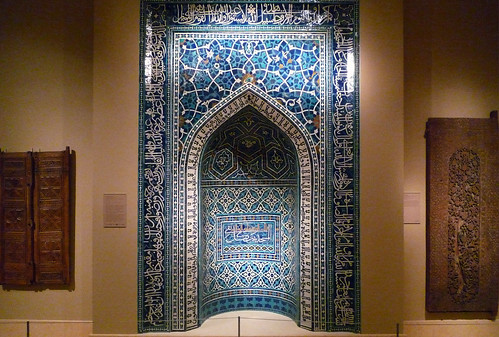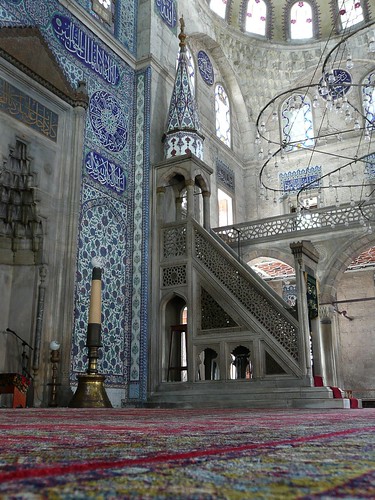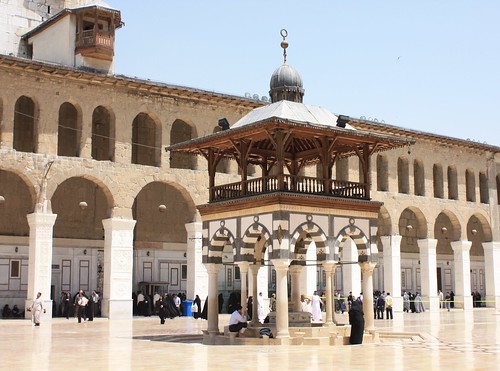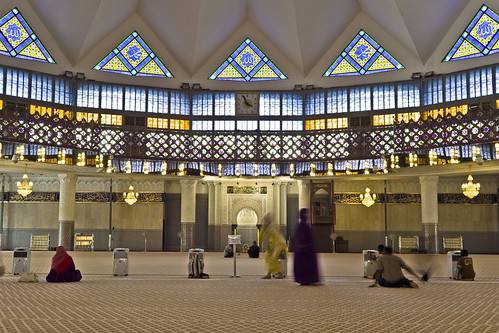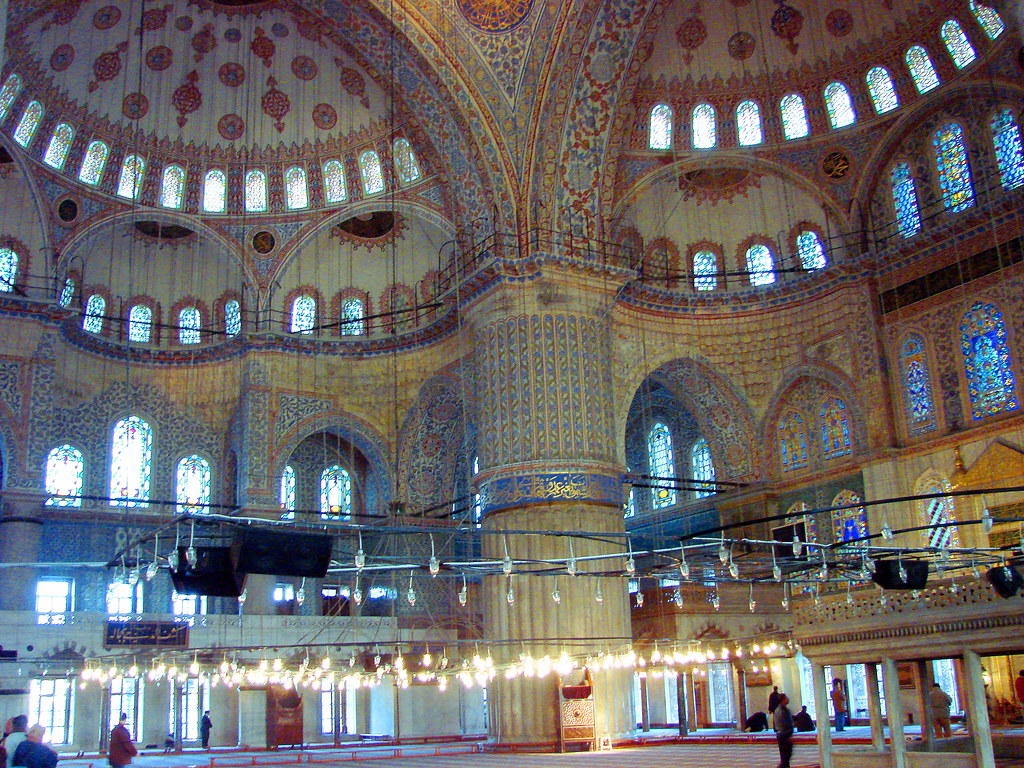Mosque Architecture 5:15

December 2013
I. Overview Video
II. Birth of the Islamic Mosque
III. Architectural Segmentation
IV. Sources
“The spiritual peace that one feels in the masjid is but one of the many blessings of visiting a House of Allah.”
-Yasir Qadhi
I. Overview Video
II. Birth of the Islamic Mosque
Then
After migrating to Medina, The Messenger of Allah, Prophet Muhammad, established the Islamic state we now see today. Muhammad saw the need for a belief system along with a social system for all aspects of the newly birthing Islamic ways of life. However, Muhammad and his followers faced a problem.
Where was the new Muslim society supposed to generate their ideas, beliefs, and address to its problems? The Muslims wanted to have a communal place where they could worship, educate, govern, direct daily aspects of life, and above all come together as a community. Seeing these common wants, a plot of land was purchased and the first ever Mosque was constructed. This mosque consisted of “…sand, its walls of brick, its pulpit of wood, and its roof from tree branches and leaves from trees” (Farahati 146). That didn’t matter to the Muslim community; what mattered to them the most was that the mosque itself was filled with the “spirituality, intimacy, cordiality, and faith and love of Allah” (Farahati 146).
Now
The Islamic mosque can be seen as the “most important organization in Islamic society.” The mosque itself contains social, political, and educational embodiments. The mosque explained in the previous section is located in Medina, Saudi Arabia and is called The Masjid-al-Quba. Click HERE to be taken to Masjid al-Quba for a 3D virtual tour!
3 Different types of Mosques:
- The Hypostyle Mosque: This mosque was the primary mosque type during the period of the Rightly Guided Caliphs. These Caliphs followed in the Prophet’s footsteps. The prayer hall in a Hypostyle Mosque is normally formed of rows of vertical supports or consists of a columned hall in which the columns can be multiplied. The minaret, mihrab, and minbar were introduced in the architecture of this mosque.
- The Iwan Mosque: This is a mosque that is mostly dominant in Iran. The prayer hall is an iwan. An iwan is a large hall or audience chamber. It is often open on one side and largely valued. An Iwan mosque can be made up of up to four iwans, which are normally surrounding a courtyard. This type of mosque was the most popular type in the medieval period.
-
The Central-Dome Mosque: In this type of mosque, the prayer hall is covered by a central dome. This central dome may be surrounded by smaller and lower semi-domes which do not necessarily cover places where prayer is done. This mosque was introduced by the Ottomans in the 15th century.
III. Architectural Segmentation
Mihrab
The mihrab marks the direction of the qibla, and should be faced during prayers. This direction is fixed toward the Kaaba in Mecca, which is the most sacred site in Islam. The mihrab is very ornate and decorated to really stand out.
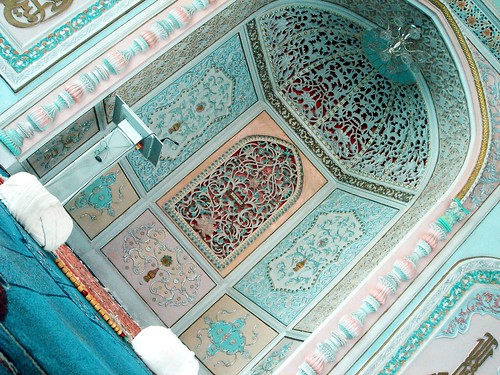
Mihrab, 1354—55, Isfahan, Iran by Steven Zucker,used under |
|
Minbar
The minbar is an elevated platform where the prayer leader delivers the sermons. It is typically in the shape of a small tower with stairs leading up to the elevated platform. In some mosques, the minbars will have a pointed roof. The minbar is located to the side of the mihrab and it is a place that symbolizes authority.
 Mihrab and Minbar, Mosque of al-Rifa’i by Christopher Rose, used under Mihrab and Minbar, Mosque of al-Rifa’i by Christopher Rose, used under  |
|
Minaret
Minarets are tall, slender towers. The number, shape, size, and style can vary from each mosque. The towers usually have a pointed roof. The minaret was originally designed as the tallest place to make the adhan, which is the Islamic call to prayer. The call to prayer is done five times everyday. In modern day mosques, most prayer halls are used to make the call to prayer. Now, most minarets provide some sort of air conditioning system.
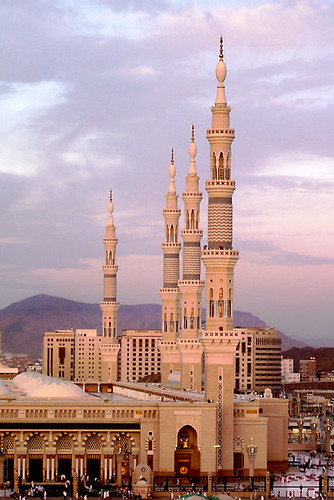
Minarets at Dawn- Medina, Saudi Arabia by Shabbir Siraj,used under |
|
Ablution Facilities
Ablution facilities vary in different mosques, yet they are necessary for a mosque for one main reason: cleanliness. Ablution is a purification process that is done each time before entering the prayer hall. In some small mosques, the ablution facility is simply the restroom. In more traditional mosques, the ablution facility is an area in the middle of courtyard. Some traditional mosques have an ablution fountain, and others have a building in the middle of the courtyard.
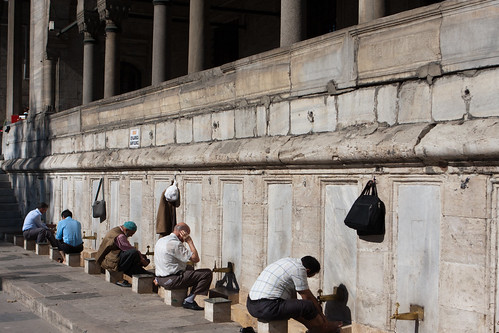 Ablution fountain, Umayyad Mosque, Damascus. by-sa Jan Smith, used under  |
|
Dome
The domes of the mosque can be vastly different. The domes have been thought to signify Heaven and the sky. Most domes are in the shape of a hemisphere. The sizes of the mosque domes have grown overtime. Some of the first domes were over just the mihrab, now most domes are very large and sometimes cover the entire prayer hall. The dome is usually decorated on the interior and exterior.
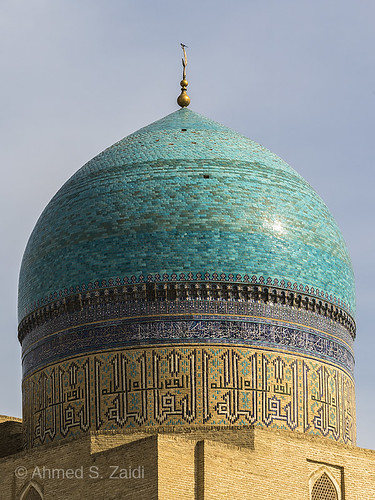 Domes Henry Patton, used under Domes Henry Patton, used under  |
|
Prayer Hall
The prayer hall is called the musalla. The prayer hall is a large, open space. With the exception of the elderly who need chairs, there is typically no furniture in the musalla because the mosque-goers kneel and sit on the floor.
 Grand Mosque, Abu Dhabi, UAE by Jan Smith, used under  |
|
Porch
The porch is a place to gather and an entryway into the mosque. The porch can be leveled and designed. The porch is located at the top of the facade. The entrance to the mosque is through the main arch of the facade.
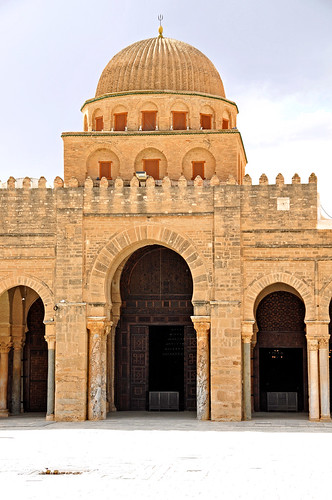
Tunisia-4565B
by Dennis Jarvis, used under 
IV. Sources
Beggerly, B. (2011, September 26). IMG_9974. [Digital Image]. Retrieved from http://www.flickr.com/photos/beggs/6294360149/sizes/m/. Available under Creative Commons Attribution 2.0.
Caulfield, A. (2007, March 12). 2007-03-11 03-17 Istanbul060 Sultan Ahmet Moschee. [Digital Image]. Retrieved from http://www.flickr.com/photos/wm_archiv/2718780662/sizes/l/. Available under Creative Commons Attribution 2.0.
cercamon. (2007, July 15). Sokollu Mehmet Pasa Camii, mirhab & minbar. [Digital Image]. Retrieved from http://www.flickr.com/photos/cercamon/822299828/sizes/m/. Available under Creative Commons Attribution- Non Commercial- Share Alike 2.0.
Farahati, A. (2011). The Mosque as the First Political-Ideological Base in the Islamic Society. [PDF file] Kashan, Esfahan, Islamic Republic of Iran.
Farrukh. (2006, December 7). Farrukh. [Digital Image]. Retrieved from http://www.flickr.com/photos/swamibu/1477404230/sizes/m/. Available under Creative Commons Attribution- Non Commercial 2.0.
Guwashi999. (2011, July 20). National Mosque of Malaysia #1. [Digital Image]. Retrieved from http://www.flickr.com/photos/guwashi999/6076562706/sizes/m/in/photolist-afXYow-cXoKNG-8aRq67-gfZcXK-cXoH1w-eyZCwe-bNmJ5Z-drZStk-buBFYH-buBDPk-gMwRin-do15Df-dnZvGH-a2Drt5-do2fU5-7MGaXK-8xxBqH-drZCXj-7yTpCG-drZRGT-86uGe2-gouZ7U-ck7wny-g37VYF-cYTQJW-g3bB3E-biR8Tg-9vHLTG-9vEKKa-8bAYde-8aYMJK-8asEV4-8b356Y-dnVcEk-atU8mK-aqz22L-bXcD9y-8ePK33-8ePywY-8eLoFn-8ePKRm-8eLqMz-8ePsRG-8eLvet-8ePTqs-8ePAA3-8eLwgz-8ePDVb-8eLfig-8P67SR-bnvfQB/. Available under Creative Commons Attribution 2.0.
Halim, D. (2010, September 7). Islamic Center, Samarinda. [Digital Image]. Retrieved from http://www.flickr.com/photos/long-long/4967147141/sizes/l/http://commons.wikimedia.org/wiki/File:Jama_masjid_dilli6.jpg. Available under Creative Commons Attribution- Non Commercial- Share Alike 2.0.
Hegedus, U. (1997). Muslim Mosque. London: A & C Black.
Jarvis, D. (2012, May 19). Tunisia-4564B. [Digital Image]. Retrieved from http://www.flickr.com/photos/archer10/7863818474/sizes/m/. Available under Creative Commons Attribution – Share Alike 2.0.
Macaulay, D. (2003). Mosque. Boston: Houghton Mifflin Company.
Patton, H. (2012, December 9). Domes. [Digital Image]. Retrieved from http://www.flickr.com/photos/hpatton/8425372028/sizes/m/. Available under Creative Commons Attribution- Non Commercial- Share Alike 2.0.
Rose, C. (2005, June 30). Mihrab and Minbar, Mosque of al-Rifa’i.[Digital Image]. Retrieved from http://www.flickr.com/photos/khowaga/2955003746/sizes/m/. Available under Creative Commons Attribution- Non Commercial 2.0.
Siraj, S.. (2005, February 19). Minarets at Dawn-Medina, Saudi Arabia. [Digital Image]. Retrieved from http://www.flickr.com/photos/shabbir/5228480/sizes/m/. Available under Creative Commons Attribution- Non Commercial- Share Alike 2.0.
Smith, J. (2009, July 15). Grand Mosque, Abu Dhabi, UAE. [Digital Image]. Retrieved from http://www.flickr.com/photos/26085795@N02/3910249801/sizes/m/. Available under Creative Commons Attribution 2.0.
Smith, J. (2010, May 12). Ablution fountain, Umayyad Mosque, Damascus. [Digital Image]. Retrieved from http://www.flickr.com/photos/26085795@N02/4702387106/sizes/m/. Available under Creative Commons Attribution 2.0.
Zaidi, A. (2013, March 18). Kalyan Mosque dome. [Digital Image]. Retrieved from website. Available under Creative Commons Attribution- Non Commercial- Share Alike 2.0.
Zucker, S. (2012, June 13). Mihrab, 1354—55, Isfahan, Iran. [Digital Image]. Retrieved from http://www.flickr.com/photos/profzucker/7610938518/sizes/m/. Available under Creative Commons Attribution-Non Commercial-Share Alike 2.0.

